ICP DAS USA I-7521D (with display) User manual
- Type
- User manual

7521/7522/7522A/7523/7524/7527
Software User’s Manual
Warranty
All products manufactured by ICP DAS are warranted against
defective materials for a period of one year from the date of delivery
to the original purchaser.
Warning
ICP DAS assume no liability for damages resulting from the use
of this product. ICP DAS reserves the right to change this manual at
any time without notice. The information furnished by ICP DAS is
believed to be accurate and reliable. However, no responsibility is
assumed by ICP DAS for its use, nor for any infringements of patents
or other rights of third parties resulting from its use.
Copyright
Copyright 2000 by ICP DAS. All rights are reserved.
Trademark
The names used for identification only may be registered
trademarks of their respective companies.
7521/7522/7522A/7523/7524/7527 Software User’s Manual (Rev. 2.1, Jul/2005, 7PS-000-21) ----- 1

Tables of Contents
1. INTRODUCTION 3
1.1 SOFTWARE INSTALLATION & DEMO PROGRAMS.......................................................................................7
1.2 QUICK START1:CONNECTING TO THE 7521..............................................................................................9
1.3 QUICK START2: CONNECTING TO SINGLE, REMOTE-RS232-DEVICE.....................................................15
1.4 QUICK START3: CONNECTING TO MULTI-REMOTE-RS232-DEVICES ....................................................20
1.5 DOWNLOADING NEW FIRMWARE TO 7521.............................................................................................23
1.6 TYPICAL APPLICATIONS.........................................................................................................................26
2. CONNECTING TO THE HP34401A 34
2.1 THE 7521 & THE HP34401A .................................................................................................................34
2.2 THE PC & THE HP34401A ....................................................................................................................35
2.3 A SINGLE-7522 & SINGLE-HP34401A..................................................................................................37
2.4 MULTI-7522 & MULTI-HP34401A .......................................................................................................44
2.5 A SINGLE-7523 & TWO-HP34401A......................................................................................................46
2.6 MULTI-7523S & MULTI-HP34401AS ....................................................................................................48
3. COMMAND SETS 50
3.1 $AAA[ADDR] ........................................................................................................................................52
3.2 $AABN[BAUD RATE].............................................................................................................................53
3.3 $AADN[DATA-BIT] ...............................................................................................................................54
3.4 $AAPN[DATA-BIT]................................................................................................................................55
3.5 $AAON[STOP-BIT] ................................................................................................................................56
3.6 $AA6(ID) ..............................................................................................................................................57
3.7 $AA7 ………………………………………………………………………………………………….58
3.8 $AAC[DELIMITER] ................................................................................................................................59
3.9 $AAD ………………………………………………………………………………………………….60
3.10 (DELIMITER)AA(BYPASS) ......................................................................................................................61
3.11 $AAK[CHECKSUM] ...........................................................................................................................62
3.12 $AATN[CRLFMODE]............................................................................................................................63
3.13 $AAW ...................................................................................................................................................64
3.14 $AAXV .................................................................................................................................................65
3.15 $AAYN .................................................................................................................................................66
3.16 $AAZNV...............................................................................................................................................67
3.17 #** ………………………………………………………………………………………………….68
3.18 $AA4 ………………………………………………………………………………………………….69
3.19 $AA5 ………………………………………………………………………………………………….70
3.20 $AAF ………………………………………………………………………………………………….71
3.21 $AAM………………………………………………………………………………………………….71
3.22 $AA2 ………………………………………………………………………………………………….72
3.23 ~** ………………………………………………………………………………………………….73
3.24 ~AA0 ………………………………………………………………………………………………….73
3.25 ~AA1 ………………………………………………………………………………………………….74
3.26 ~AA2 ………………………………………………………………………………………………….75
3.27 ~AA3ETT .............................................................................................................................................76
3.28 ~AA4P & ~AA4S .................................................................................................................................77
3.29 ~AA5P & ~AA5S .................................................................................................................................78
3.30 $AAU ………………………………………………………………………………………………….79
3.31 $AAL(DATA)..........................................................................................................................................80
3.32 $AAR ………………………………………………………………………………………………….81
4. OPERATIONAL PRINCIPLES & APPLICATION NOTES 82
4.1 DI1/INIT* PIN OPERATION PRINCIPLES ................................................................................................82
4.2 D/O OPERATING PRINCIPLES .................................................................................................................83
4.3 D/I OPERATING PRINCIPLES...................................................................................................................83
4.4 DUAL WATCHDOG OPERATION PRINCIPLE ............................................................................................84
4.5 HOST WATCHDOG APPLICATIONS NOTES .............................................................................................84
4.6 MODULE WATCHDOG APPLICATIONS NOTES ........................................................................................85
4.7 SOURCE CODE OF THE 7521/7522/7523 .................................................................................................85
7521/7522/7522A/7523/7524/7527 Software User’s Manual (Rev. 2.1, Jul/2005, 7PS-000-21) ----- 2

1. Introduction
Introduction
There are many RS-232 devices used in industry applications.
Nowadays, linking all these RS-232 devices together for both
automation & information important. Usually, these devices are far
away from the host-PC. In modern situation, multi-serial card linking
is inefficient. Our 752x series products can link multiple RS-232
devices via a single RS-485 network. This network protocol offers
stability, reliability and simple cabling while delivering a low –cost,
easy-to-maintain product..
Addressable RS-232 Converter
Most RS-232 devices don’t support device addresses. Our I-752X
series can assign a unique address to any RS-232 device installed in a
RS-485 network. Once the host-PC sends a command with a device
address to the RS-485 network, the destination-752x will remove the
address field & pass the other commands to its local RS-232 device.
The response of this local RS-232 device will be returned to the host-
PC via the I-752x.
Master-type Addressable RS-232 Converter
ICPDAS’ 752x products are unique. Our 752X products are Master-
type converters, while other converters are Slave-type. Slave-type
converters are helpless without a host-PC. In real industrial
applications, customers are not satisfied with Slave-type converters
because they can not adapt to individual demands. The powerful 752x
series analyzes local RS-232 devices, D/I or D/O without a host-PC.
Refer to Application 5~9 for more information.
Onboard 1K byte Queue-buffer
The I-752X equips a 1K byte queue-buffer for its local RS-232
device. All input data can be stored in the queue-buffer until the host-
PC has time to read it. These features allow the host-PC to link
thousands of RS-232 devices without losing any data.
7521/7522/7522A/7523/7524/7527 Software User’s Manual (Rev. 2.1, Jul/2005, 7PS-000-21) ----- 3

Onboard D/I signal trigger
The I-752X is equipped with 3-channels of digital input for sensor
interfacing. These D/I are linked to a photo sensor/switch to act as a
signal. They also can be used as general purpose D/I. The 752X can
read & analyze these D/I without the help of host-PC.
Onboard D/O for emergency control
The I-752X equips 3-channels of digital output for emergency
control. The D/O can directly drive relay or led. They can be used to
control the local devices for emergency event. The 752x can control
these D/O without the help of host-PC.
3000V isolation on RS-485 site
The COM2 of the I-752x is an isolated RS-485 port with 3000V
isolation. This isolation will protect the local RS-232 devices from
transient noises coming from RS-485 network.
Self-Tuner ASIC inside
The I-752X Self-Tuner ASIC for RS-485 port. This chip can auto
detect and control the send/receive direction of the RS-485 network.
Therefore the application programs don’t have to take care of the
direction control of the RS-485 network.
Embedded control capabilities
Besides Intelligent Communication Controller, the I-752X series
products can be used as an embedded controller. Every I-752X
controller has a, MiniOS7, embedded O.S.. The MiniOS7 provides
equivalent functions of ROM DOS and has more features. The user can
use well-developed libraries and demo programs to implement his
controller.
Wide range selection
The I-752X series products have I-7521, I-7521D, I-7522, I-7522D,
I-7522A, I-7522A, I-7523, I-7523D, I-7524, I-7524D, I-7527 and I-
7527D. The I-7521 provides one RS-232 port, one RS-485 port, 3
digital input channels and 3 digital output channels. The I-7522
provides two RS-232 ports, one RS-485 port, two digital input channels
and one digital output channel. The I-7522A provides one RS-232/RS-
7521/7522/7522A/7523/7524/7527 Software User’s Manual (Rev. 2.1, Jul/2005, 7PS-000-21) ----- 4

485 port, one RS-485 port, one RS-422/RS-485 port, 5 digital input
channels and 5 digital output channels. The I-7523 provides three RS-
232 ports, one RS-485 port. The I-7524 provides 4 RS-232 ports, two
RS-485 ports, 1 digital input channels and 1 digital output channels.
The I-7527 provides seven RS-232 ports, two RS-485 ports, 1 digital
input channels and 1 digital output channels. The COM 1 of the I-7521,
I-7522, I-7522A, I-7523, I-7524 and I-7527 can be used as RS-232 port
or RS-485 port.
The 7188XC/XB & 752X series
The 7521/22/22A/23/24/27 is really an embedded controller before
any firmware is downloaded. After downloading the firmware, the
7521/22/22A/23/24/27 acts as an “Intelligent Communication
Controller”. The only difference between the 7521/22/23 & the
7188XC is the 3000V isolation on the RS-485 port. In general, the
7521/22/23 is equivalent to 7188XC+7510. Therefore the
7521/7522/7523 can be used as an embedded controller with an
isolated RS-485 port. The only difference between the 7522A/24/27 &
the 7188XB is the 3000V isolation on the RS-485 port. In general, the
7522A/24/27 is equivalent to 7188XB+7510. Therefore the
7522A/7524/7527 can be used as an embedded controller with an
isolated RS-485 port.
Cost Effective Solution
The 7188/7188XA/7188XB/7188XC is designed as an embedded
controller. Therefore, an any software can be downloaded to them. If
the firmware for “Intelligent Communication Controller” is
downloaded to the into 7188/7188XA/7188XB/7188XC, they will act
as an “Intelligent Communication Controller”.
7188XC
A cost-effective “embedded controller”.
Intelligent
Communication
Controller
Firmware
+
A cost-effective “Intelligent Communication
Controller” (without isolation on RS-485 port)
7521/7522/7522A/7523/7524/7527 Software User’s Manual (Rev. 2.1, Jul/2005, 7PS-000-21) ----- 5

Features
Built-in “Addressable RS-232 Converter” firmware
Supports about 30 well-defined commands
Supports Dual-Watchdog commands
Supports Power-up value & safe value for D/O
The source code of firmware is open & well-documented
User can modify the source code according to their specific
requirements.
The firmware can monitor the onboard D/I and control the
onboard D/O in real-time according to user’s requirements
The firmware can monitor the RS-232 device and control the
onboard D/O in real-time according to user’s requirements
The 7521 supports one RS-232 device
The 7522 supports two RS-232 devices
The 7522A supports one RS-232 device
The 7523 supports three RS-232 devices
The 7524 supports four RS-232 devices
The 7527 supports seven RS-232 devices
Watchdog timer provides fault tolerance and recovery
Low power consumption
Ordering Information
7521 : Single-channel “Intelligent Communication Controller”
7521D : 7521 with 5-digit 7-seg LED.
7522 : Dual-channel “Intelligent Communication Controller”
7522D : 7522 with 5-digit 7-seg LED.
7522A : Single-channel “Intelligent Communication Controller”
7522AD : 7522A with 5-digit 7-seg LED.
7523 : Three-channel “Intelligent Communication Controller”
7523D : 7523 with 5-digit 7-seg LED.
7524 : Four-channel “Intelligent Communication Controller”
7524D : 7522 with 5-digit 7-seg LED.
7527 : Seven-channel “Intelligent Communication Controller”
7527D : 7522 with 5-digit 7-seg LED.
7521/7522/7522A/7523/7524/7527 Software User’s Manual (Rev. 2.1, Jul/2005, 7PS-000-21) ----- 6

1.1 Software installation & demo programs
Software Installation:
• make a working directory in your computer, then
• insert the installation CD and wait for autorun(or Run auto32.exe)
• click “Toolkits(Softwares)/ Manuals”
• click “718XA/B/C & 7521/2/2A/3/4/7 Series”
• click “Demo Program”, the following like window is shown:
Select all the files and directories and copy them to the working
location/directory
• Copy the 7188X.EXE/7188XW.EXE to the PATH directory, for
example, C:\DOS or C:\WINDOWS, then you can execute
7188X.EXE/7188XW.EXE from any location.
Files description:
File name Location Description Hardware
Xbyymmdd.img 7188XB\DEMO\ The image file for MiniOS7
yy:002000
mm: month
dd: day
7522A/7524/
7527
7522A.C 7188XB\DEMO\TC30\7522A The source code of 7522A 7522A
7522A.EXE 7188XB\DEMO\TC30\7522A The firmware of 7522A 7522A
7524.C 7188XB\DEMO\TC30\7524 The source code of 7524 7524
7524.EXE 7188XB\DEMO\TC30\7524 The firmware of 7524 7524
7527.C 7188XB\DEMO\TC30\7527 The source code of 7527 7527
7527.EXE 7188XB\DEMO\TC30\7527 The firmware of 7527 7527
Xcyymmdd.img 7188XC\DEMO\ The image file for MiniOS7
yy:002000
mm: month
dd: day
7521/7522/
7523
7521.C 7188XC\DEMO\BC\7521 The source code of 7521 7521
7521.EXE 7188XC\DEMO\BC\7521 The firmware of 7521 7521
7522.C 7188XC\DEMO\BC\7522 The source code of 7522 7522
7522.EXE 7188XC\DEMO\BC\7522 The firmware of 7522 7522
7523.C 7188XC\DEMO\BC\7523 The source code of 7523 7523
7523.EXE 7188XC\DEMO\BC\7523 The firmware of 7523 7523
7521/7522/7522A/7523/7524/7527 Software User’s Manual (Rev. 2.1, Jul/2005, 7PS-000-21) ----- 7

start
7188XC\ Containing source code for Quick Start. 7521/7522
/7523
com.h
7188XC\start Header file for all quick start program 7521/7522
/7523
hp34401a.c
7188XC\start PC link to HP34401A 7521/7522
/7523
hp22_1.c
7188XC\start 7522 link to HP 34401A 7521/7522
/7523
hp22_m.c
7188XC\start Multi-7522 link to HP 34401A 7521/7522
/7523
hp23_1.c
7188XC\start 7523 link to HP 34401A 7521/7522
/7523
hp23_m.c
7188XC\start Multi-7523 link to HP 34401A 7521/7522
/7523
7521ODM1
7188XC\DEMO\BC\ 7521+ real time control D/IO 7521
7521ODM2
7188XC\DEMO\BC\ 7521+
real time control AD&DA
7521
7521ODM3
7188XC\DEMO\BC\ 7521+
real time control Event counter
7521
7521ODM4
7188XC\DEMO\BC\ 7521+
real time control Sensor & Multiplex
7521
7521ODM5
7188XC\DEMO\BC\ 7521+
real time monitor HP34401A & alarm
control
7521
lib
7188XB\DEMO\ 7188xbs.libfor SMALL program.
(TC/BC++/MSC/MSVC++)
7188xbl.libfor LARGE program.
(TC/BC++/MSC/MSVC++)
7188xb.hAll the functions declared
are in the 7188xb.h, please use
#include”7188xb.h”. 7188xb.h is put on
the same directory as 7188xbs.lib
7522A/7524/
7527
lib
7188XC\ 7188xs.libfor SMALL program.
(TC/BC++/MSC/MSVC++)
7188xl.libfor LARGE program.
(TC/BC++/MSC/MSVC++)
7188x.hAll the functions declared are
in the 7188x.h, please use
#include”7188x.h”. 7188x.h is put on
the same directory as 7188xs.lib
7521/7522/
7523
7521/7522/7522A/7523/7524/7527 Software User’s Manual (Rev. 2.1, Jul/2005, 7PS-000-21) ----- 8

1.2 Quick Start1:Connecting to the 7521
Step 1: connect the 7521 to the RS-485 networking as follows:
7520
7521/7522/22A/7523/7524/7527
RS-232 RS-485
Host PC
RS-232
Signal
10
11
12
13GND
+VS
D2-
D2+
7521/7521D
7522/7522D
7522A/7522AD
7523/7523D
7524/7524D
7527/7527D
7
6
5
4
3
8
2
1
9
10
Female 9-pin D-sub
GND
+VS
Date+
Date-
7520
6
7
8
9
1
2
3
4
5
7520R
6
7
8
9
1
2
3
4
5
Male 9-pin D-sub
Com 1/2/3/4 or
UART port
Host
-
PC
RS-485
Signal
Ext. GND
Ext. 24V
9
8
7
6
5
4
3
2
1
Male 9-pin D-sub
7521/7522/7522A/7523/7524/7527 Software User’s Manual (Rev. 2.1, Jul/2005, 7PS-000-21) ----- 9

Step 2: Execute 7188X.EXE in the Host-PC
Step 3: Select the active COM port of HOST-PC
If the 7520 is connected to COM1, then Press ALT & 1
If the 7520 is connected to COM2, then Press ALT & 2
Step 4: Change the baud rate to 9600
Press ALT & C first
Then press the SPACE-key several times until baud rate = 9600
Press the ENTER-key to confirm
Step 5: Change the Parity-bit to N
Press the SPACE-key several times until Parity-bit = N
Press the Enter-key to confirm
Step 6: Change the Data-bit to 8
Press the SPACE-key several times until Data-bit = 8
Press the Enter-key to confirm
Step 7: Change the Stop-bit to 1
Press the SPACE-key several times until Stop-bit = 1
Press the Enter-key to confirm
Step 8:Change the 7188x to Line-Command-mode
Press ALT & L
The screen will show as follows:
7521/7522/7522A/7523/7524/7527 Software User’s Manual (Rev. 2.1, Jul/2005, 7PS-000-21) ----- 10

Step 9: Power-on the 7521(make sure DI1/INIT* is floating)
Check that the five 7-seg LED shows as follows:
Step 10: Get the Module-Name of the 7521
Key-in command $01M
Then press the ENTER-key to send command to the 7521
Check that the 7521 echoes !017521
Step 11: Get the Version of the 7521
Key-in command $01F
Then press the ENTER-key to send command to the 7521
Check that the 7521 echoes !01A1.0
Key-in command $012
Then press the ENTER-key to send command to 7521
Check that the 7521 echoes !016800
Address=01
Baud rate=9600
Reserved for user
7521/7522/7522A/7523/7524/7527 Software User’s Manual (Rev. 2.1, Jul/2005, 7PS-000-21) ----- 11

Step 12:Change the Module-Address of the 7521
Key-in command $01A02
Then press the ENTER-key to send command to the 7521
Check that the five 7-seg LED will shows as follows:
Key-in command $02M
Then press the ENTER-key to send command to the 7521
Check that the 7521 echoes !027521
Address=02
Baud rate=9600
Reserved for user
7521/7522/7522A/7523/7524/7527 Software User’s Manual (Rev. 2.1, Jul/2005, 7PS-000-21) ----- 12

Step 13:Change the baud rate of the 7521
Key-in command $02B0115200
Then press the ENTER-key to send command to the 7521
Check that the five 7-seg LED shows as follows:
Press ALT & C
Press the SPACE-KEY until 115200 is shown
Then press the ENTER-KEY to confirm baud rate=115200
Press the ENTER-KEY to confirm parity-bit=N
Press the ENTER-KEY to confirm data-bit=8
Press the ENTER-KEY to confirm stop-bit=1
Key-in command $02M
Then press the ENTER-key to send command to the 7521
Check that the 7521 echoes !027521
Key-in command $022
Then press the ENTER-key to send command to the 7521
Check that the 7521 echoes !02A800
Address=02
Baud rate=115200
Reserved for user
7521/7522/7522A/7523/7524/7527 Software User’s Manual (Rev. 2.1, Jul/2005, 7PS-000-21) ----- 13

Step 14: Change the Module-Address of the the 7521
Key-in command $02A01
Then press the ENTER-key to send command to the 7521
Step 15: Change the baud rate of the 7521
Key-in command $01B09600
Then press the ENTER-key to send command to the 7521
Press ALT & C
Press the SPACE-KEY until 9600 is shown
Then press the ENTER-KEY to confirm baud rate=9600
Press the ENTER-KEY to confirm parity-bit=N
Press the ENTER-KEY to confirm data-bit=8
Press the ENTER-KEY to confirm stop-bit=1
Key-in command $01M
Then press the ENTER-key to send command to the 7521
Check the 7521 echoes !017521
7521/7522/7522A/7523/7524/7527 Software User’s Manual (Rev. 2.1, Jul/2005, 7PS-000-21) ----- 14

1.3 Quick Start2: Connecting to Single,
Remote-RS232-Device
Step 1: connect the 7521 to the RS-485 networking & remote-PC as
follows:
7520
7521/7522/7522A/7523/7524/7527
RS-232 RS-485
Host PC
Remote PC
RS-232
Signal
10
11
12
13
GND
+VS
D2-
D2+
7521/7521D
7522/7522D
7523/7523D
7
6
5
4
3
8
2
1
9
10
Female 9-pin D-sub
GND
+VS
Date+
Date-
7520
6
7
8
9
1
2
3
4
5
7520R
6
7
8
9
1
2
3
4
5
Male 9-pin D-sub
Com 1/2/3/4 or
UART port
H o st-P C
RS-485
Signal
Ext. GND
Ext. 24V
9
8
7
6
5
4
3
2
1
Male 9-pin D-sub
6
7
8
9
1
2
3
4
5
Male 9-pin D-sub
Com 1/2/3/4 or
UART port
R em ote-PC
RS-232
Signal
7521/7522/7522A/7523/7524/7527 Software User’s Manual (Rev. 2.1, Jul/2005, 7PS-000-21) ----- 15

Step 2: Execute 7188X.EXE in the Host-PC
Refer to Step3 through o Step 8 of Quick Start 1 to change
COM port & status to 9600, N, 8, 1
Step 3: Execute 7188X.EXE in the Remote-PC
Refer to Step3 through Step 8 of Quick Start 1 to change
COM port & status to 9600, N, 8, 1
Step 4: Host-PC Sends abcde to Remote-PC
Keyin :01abcde
Press the Enter-key to send command string to the 7521
Check that the response-string from Remote-PC is abcde
The screen should be shown on Host-PC as follows:
RS-232
Signal
11
12
13
14
GND
+VS
D2-
D2+
7522A/7522AD
7524/7524D
7527/7527D
7
6
5
4
3
8
2
1
9
10
Female 9-pin D-sub
GND
+VS
Date+
Date-
7520
6
7
8
9
1
2
3
4
5
7520R
6
7
8
9
1
2
3
4
5
Male 9-pin D-sub
Com 1/2/3/4 or
UART port
H o st-PC
RS-485
Signal
Ext. G N D
Ext. 24V
6
7
8
9
1
2
3
4
5
Male 9-pin D-sub
Com 1/2/3/4 or
UART port
R em ote-P C
RS-232
Signal
7
8
9
10
IN IT *
RXD1
TXD1
GND
7521/7522/7522A/7523/7524/7527 Software User’s Manual (Rev. 2.1, Jul/2005, 7PS-000-21) ----- 16

7521/7522/7522A/7523/7524/7527 Software User’s Manual (Rev. 2.1, Jul/2005, 7PS-000-21) ----- 17

The screen on the Remote-PC should show as follows:
Step 5: Host-PC Sends 12345 to Remote-PC
Keyin :0112345
Press the Enter-key to send command string to the 7521
Check that the response-string from Remote-PC is 12345
The screen should be shown on Host-PC as follows:
7521/7522/7522A/7523/7524/7527 Software User’s Manual (Rev. 2.1, Jul/2005, 7PS-000-21) ----- 18

The screen on the Remote-PC should show as follows:
Note: If no Remote-PC is available. One can connect TxD and Rxd to
the same COM port to test:
7521/7522/7522A/7523/7524/7527 Software User’s Manual (Rev. 2.1, Jul/2005, 7PS-000-21) ----- 19

1.4 Quick Start3: Connecting to Multi-
Remote-RS232-Devices
Step 1: Refer to Quick Start1 for wiring & change the 7521 to Address-
02, & 9600, N, 8, 1
Step 2: connect the second 7521 to the RS-485 networking & two
remote-PCs as follows:
Now there are two 7521s in the RS-485 network. The module address
of one 7521 is address-01, the other is address-02. The
communication status of these two 7521 will be same as N, 8, 1
Step 3: Execute 7188X.EXE in the two, Remote-PCs
Refer to Step3 through Step 8 of Quick Start 1 to change
COM port & status to 9600, N, 8, 1
7520
7521/7522/7522 A
7523/7524/7527
address 01/01/01
01/01/01
RS-232
RS-485
Host PC
Remote PC #1
7521/7522/7522
A
7523/7524/7527
address 02/03/02
04/05/08
Remote PC #2
7521/7522/7522A/7523/7524/7527 Software User’s Manual (Rev. 2.1, Jul/2005, 7PS-000-21) ----- 20
Page is loading ...
Page is loading ...
Page is loading ...
Page is loading ...
Page is loading ...
Page is loading ...
Page is loading ...
Page is loading ...
Page is loading ...
Page is loading ...
Page is loading ...
Page is loading ...
Page is loading ...
Page is loading ...
Page is loading ...
Page is loading ...
Page is loading ...
Page is loading ...
Page is loading ...
Page is loading ...
Page is loading ...
Page is loading ...
Page is loading ...
Page is loading ...
Page is loading ...
Page is loading ...
Page is loading ...
Page is loading ...
Page is loading ...
Page is loading ...
Page is loading ...
Page is loading ...
Page is loading ...
Page is loading ...
Page is loading ...
Page is loading ...
Page is loading ...
Page is loading ...
Page is loading ...
Page is loading ...
Page is loading ...
Page is loading ...
Page is loading ...
Page is loading ...
Page is loading ...
Page is loading ...
Page is loading ...
Page is loading ...
Page is loading ...
Page is loading ...
Page is loading ...
Page is loading ...
Page is loading ...
Page is loading ...
Page is loading ...
Page is loading ...
Page is loading ...
Page is loading ...
Page is loading ...
Page is loading ...
Page is loading ...
Page is loading ...
Page is loading ...
Page is loading ...
Page is loading ...
-
 1
1
-
 2
2
-
 3
3
-
 4
4
-
 5
5
-
 6
6
-
 7
7
-
 8
8
-
 9
9
-
 10
10
-
 11
11
-
 12
12
-
 13
13
-
 14
14
-
 15
15
-
 16
16
-
 17
17
-
 18
18
-
 19
19
-
 20
20
-
 21
21
-
 22
22
-
 23
23
-
 24
24
-
 25
25
-
 26
26
-
 27
27
-
 28
28
-
 29
29
-
 30
30
-
 31
31
-
 32
32
-
 33
33
-
 34
34
-
 35
35
-
 36
36
-
 37
37
-
 38
38
-
 39
39
-
 40
40
-
 41
41
-
 42
42
-
 43
43
-
 44
44
-
 45
45
-
 46
46
-
 47
47
-
 48
48
-
 49
49
-
 50
50
-
 51
51
-
 52
52
-
 53
53
-
 54
54
-
 55
55
-
 56
56
-
 57
57
-
 58
58
-
 59
59
-
 60
60
-
 61
61
-
 62
62
-
 63
63
-
 64
64
-
 65
65
-
 66
66
-
 67
67
-
 68
68
-
 69
69
-
 70
70
-
 71
71
-
 72
72
-
 73
73
-
 74
74
-
 75
75
-
 76
76
-
 77
77
-
 78
78
-
 79
79
-
 80
80
-
 81
81
-
 82
82
-
 83
83
-
 84
84
-
 85
85
ICP DAS USA I-7521D (with display) User manual
- Type
- User manual
Ask a question and I''ll find the answer in the document
Finding information in a document is now easier with AI
Related papers
-
ICP DAS USA I-7527 User manual
-
ICP DAS USA I-7527 User manual
-
ICP DAS USA I-7188XCD Quick start guide
-
ICP DAS USA I-7188XBD-512 (with 7 segment display) User manual
-
ICP DAS USA I-7188E1D User manual
-
ICP DAS USA I-7527 Quick start guide
-
ICP DAS USA I-8014CW Quick start guide
-
ICP DAS USA I-7188XA - Embedded Controller with 2-channel DI and DO, supports C programming and RS-485/RS-232 User manual
-
ICP DAS USA I-7188XAD Quick start guide
-
ICP DAS USA I-8431 User manual
Other documents
-
Candy GO W485D-66 User manual
-
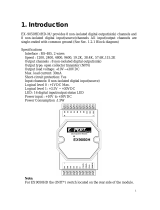 ExpertDAQ EX9050HD User manual
ExpertDAQ EX9050HD User manual
-
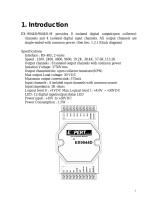 ExpertDAQ EX9044D User manual
ExpertDAQ EX9044D User manual
-
 ExpertDAQ EX-9060D-M User manual
ExpertDAQ EX-9060D-M User manual
-
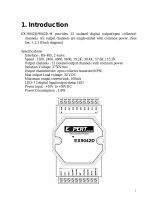 ExpertDAQ EX9042D-M User manual
ExpertDAQ EX9042D-M User manual
-
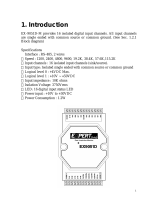 ExpertDAQ EX9055D-M User manual
ExpertDAQ EX9055D-M User manual
-
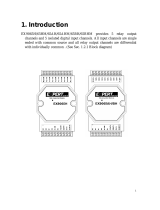 ExpertDAQ EX9065BHD-M User manual
ExpertDAQ EX9065BHD-M User manual
-
Smart-AVI HDC-MXS Datasheet
-
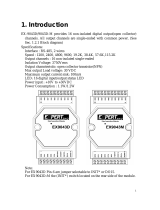 ExpertDAQ EX9043D User manual
ExpertDAQ EX9043D User manual
-
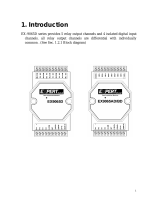 ExpertDAQ EX9065B User manual
ExpertDAQ EX9065B User manual




























































































